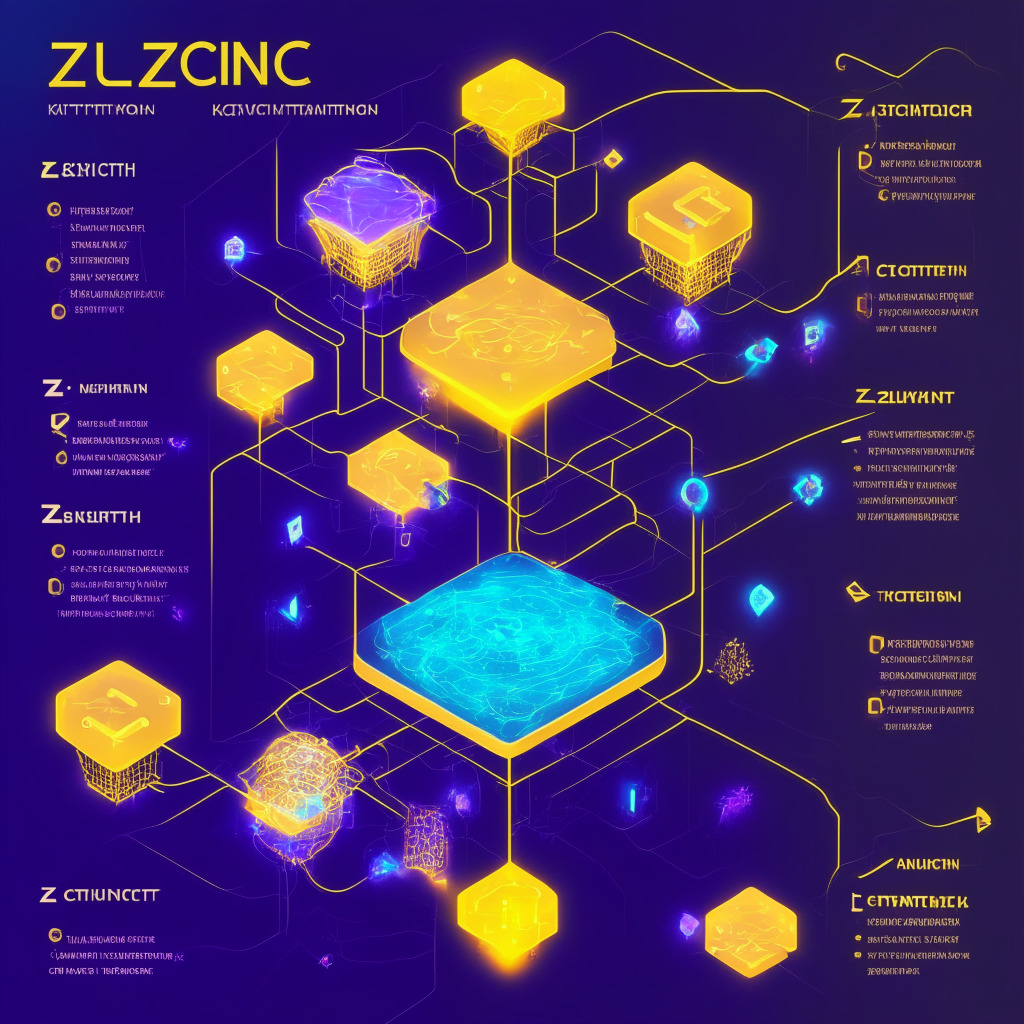“Matter Labs, in a key move towards decentralisation, has launched a new zkSync ecosystem portal. Partnering with DappRadar, Matter Labs seeks to refocus on the development of the zkSync technology. Amid challenges, this bold shift could potentially revolutionise Ethereum and blockchain technology.”
Search Results for: zksync
Balancing Crypto Security: De.Fi’s Antivirus Tool and User Responsibility on zkSync Era Blockchain
De.Fi’s antivirus tool can safeguard users from malicious exploits such as phishing in the crypto industry by providing an additional layer of security. This tool functions by connecting wallets or scanning smart contract addresses on the De.Fi platform. However, successful risk mitigation also relies on the users’ own due diligence and vigilance.
Era Lend on zkSync: Analyzing a $3.4 Million Security Breach’s Impact on the Future of Blockchain
“Era Lend, a lending protocol on the Ethereum scaling blockchain zkSync, experienced a significant security breach via a $3.4 million read-only reentrancy attack. This event led to a nearly 40% drop in its total locked capital, highlighting the ongoing issue of blockchain security vulnerabilities. However, incidents like these also provide essential lessons towards building a more resilient and secure blockchain ecosystem.”
Ankr and Matter Labs Unite for zkSync Era Nodes on Microsoft Azure: A Major Blockchain Leap
Ankr and Matter Labs collaboratively launched zkSync Era Nodes and Hyperchain blockchain solutions on Microsoft Azure Marketplace, enhancing Ethereum’s Layer-2 scaling protocol. It enables businesses and Web3 projects to connect and build applications on zkSync Era, including bespoke blockchain application.
Harnessing the Future: zkSync’s Boojum and the Transformation of the Crypto-Landscape
zkSync Era’s latest launch, a STARK-based proof system called Boojum, aims to increase capacity while reducing fees in the Ethereum scaling protocols landscape. The system offers significant scalability and transparency improvements and promises superior processing capabilities. It seeks to make cryptosystems more accessible, potentially initiating a transformative shift in blockchain technology towards mass usability.
Ethereum Scaling Showdown: zkSync Era Surpasses $500M TVL – Winners, Losers, and Future Impacts
Matter Labs’ zkSync Era, a zero-knowledge rollup technology for scaling Ethereum, has seen its total value locked (TVL) surpass $500 million. This reflects a 12% growth in one week, indicating strong demand for advanced scaling solutions in the decentralized finance (DeFi) space.
Integrating Liquid Staking into zkSync Era: Exploring Advantages and Overcoming Challenges
Era’s integration with Rocket Pool allows users to stake ether (ETH) while holding rETH and receiving rewards automatically. Though facing challenges, Rocket Pool’s research team explores zk proof technology for potential advantages like lower costs, increased efficiency, and a streamlined system.
zkSync vs. Arbitrum: Layer 2 Battle Heats Up as Transaction Records Shatter
zkSync achieves one million transactions in 24 hours, ranking as the second top L2 network behind Ethereum. Increasing transaction speed and reducing fees, zkSync attracts interest from projects like 1inch, Chainlink, and Uniswap. Despite impressive milestones, users should consider the risks, including past mainnet malfunctions.
Buenos Aires Paves the Way: Integrating Blockchain into City Administration
“Buenos Aires is integrating blockchain technology into its administrative functioning. Residents can access identity documents via a digital wallet from October. This decentralization improves security, although questions arise about privacy and the digital divide. Diego Fernandez views this as a public good, setting a benchmark for using blockchain technology for citizen benefits.”
Pudgy Penguins Leap from Virtual to Physical: The NFT Collection Hitting Walmart Shelves
The popular NFT collection, Pudgy Penguins, ventures into the physical market with its Pudgy Toys collection in 2,000 Walmart stores across the US. Each toy comes with a unique QR code linking to its online digital counterpart in the Pudgy World. This has boosted the NFT’s trading volume and highlights the evolving interaction with digital brands.
Exploring Blue-Chip Versus Meme Coins: Courage or Caution in Crypto Markets?
Tuesday’s blue-chip crypto markets, including Bitcoin and Ether, while robust, are beneath 21-day Moving Averages and anticipate potential losses due to a strong US dollar and high interest rates. Meanwhile, Poleis Finance, a significant player in decentralized finance, has seen a price surge, despite imposing high transaction taxes. Unregulated ‘meme coins’ like HarryPotterObamaPacMan8Inu and others are promising but risky, with potential profit or loss hinging on timely investments and market volatility.
Navigating Bitcoin’s Metamorphosing Landscape amidst Economic Turmoil and Blockchain Evolution
“Jamie Coutts of Bloomberg suggests significant shifts in Bitcoin’s patterns amid economic tension. However, he reveals a potential silver lining due to Bitcoin’s adaptability and controlled inflation schedules. Additionally, blockchain technology shows promise with Matter Labs transferring their zkSync platform management to DappRadar, marking progress towards total decentralization.”
Unraveling the Regulatory and Ethical Quagmires: Navigating through the Crypto Landscape
A U.S. federal judge delayed a sentencing hearing for radio host Ian Freeman, who allegedly created an illegal Bitcoin exchange used by scammers. Meanwhile, the DeFi Education Fund contests a patent claim by tech company True Return Systems. Also, DigiFT’s dETH0924 provides up to 4% APR, boosting Ethereum’s PoS mechanism, while crypto infrastructure provider Qredo integrated Circle’s USDC stablecoin into its wallet.
Manta Network’s Leap Forward: Gains and Regulatory Risks in Layer 2 Solutions
“Manta Network has launched its zero-knowledge proof layer 2 scaling network, an innovative platform for ZK-enabled DApp development. This introduces increased throughput and reduced gas fees, promising future DApps realm expansion. However, challenges and regulatory issues, as highlighted by the Celsius incident, suggest the need for careful navigation in blockchain tech.”
Crypto Sneak Attack: How One User Commandeered 21,877 Wallets in a Masterful Sybil Assault
“A complex Sybil attack was recently executed on zkSync, a layer-2 scaling solution for Ethereum, enabling the aggressor to gain control over 21,877 wallets. This carefully planned attack highlights the increasing occurrence of Sybil attacks in the crypto world, posing significant threats to airdrops and raising concerns about the security and integrity of the rapidly evolving crypto market.”
Arbitrum’s Fall: Unraveling the Possible Causes Behind its 14.5% Price Drop
Arbitrum, a leading layer-2 Ethereum solution, faces a downturn marked by a 14.5% token price plunge, decreased decentralized application activity, and a dip in total value locked (TVL) to $1.6 billion. This suggests potential investor uncertainty amidst growing competition and declining network usage, casting doubt on ARB’s future unless it successfully boosts transaction volumes and expands its user base.
Scaling the Ethereum Blockchain: The Promising Rise and Potential Pitfalls of Layer 2 Solutions
To combat increasing transaction times and fees, Ethereum is utilizing layer 2 scaling solutions, resulting in faster transaction speeds, lower costs, and maintaining security. These networks enhance throughput and transaction rates, drawing significant attention. However, layer 2 chains also face criticism, largely from crypto users maximizing profitability through airdrop farming.
Ethereum Supreme Court: A Solution for DeFi’s Contract Disputes or a Threat to Small Protocols?
Matter Labs CEO, Alex Gluchowski proposes an “Ethereum Supreme Court” for dealing with recurring smart contract disputes in DeFi. His vision involves a blockchain-based court system, similar to real-world judiciaries, to provide resolution for contract-related disagreements, particularly focusing on enhancing measures to handle unforeseen vulnerabilities and emergencies in Layer 2 implementations.
Enhancing Blockchain Security: A Deep Dive into OpenZeppelin’s Defender 2.0
OpenZeppelin, a pioneer in blockchain security, revealed Defender 2.0, a security enhancement specifically for blockchain communities that integrates a security audit into blockchain-based algorithms, mitigating potential cybersecurity vulnerabilities in creating secure decentralized applications. It’s aimed to strengthen smart contract security from development to deployment.
Polygon’s Ambitious Leap: Is The Cryptoworld Ready for the ZK-Powered Value Layer?
Ethereum scaling firm Polygon has unveiled a toolkit for blockchain developers to create customized Layer 2 chains with zero-knowledge (ZK) proofs. This opens up potentials for evolving ‘Supernets’ using the firm’s ZK technology, aiming to build the “Value Layer of the internet”.
Navigating the Future of Blockchain: Innovation Progress Spurred by Cryptography, Regulation and Social Integration
“Binance Labs has invested in Delphinus Lab, a project exploring zero-knowledge cryptography in WASM environments. Meanwhile, Num Finance has launched a Colombian peso-pegged token on the Polygon network, with the potential regulatory scrutiny. Elsewhere, Unstoppable Domains has released a messaging feature for secure blockchain-based social interaction.”
1inch Joins Coinbase’s Ethereum Layer 2: The Progress, Promise and Pitfalls of Base Network
Decentralized exchange aggregator 1inch has partnered with Coinbase’s Ethereum Layer 2 network Base, aiming to leverage liquidity from 15 functioning decentralized exchanges. The agreement introduces 1inch’s limit order protocol, contrasting from standard instant price conversions, and integrating Base within robust Layer 2 networks like Optimism, Arbitrum, and zkSync Era. Despite impressive growth and transaction rates, Base faces challenges with a high proportion of meme coin activity, suggesting potential volatility.
PancakeSwap v3’s Expansion to Linea: A Revolution in DeFi or High-Risk Gamble?
PancakeSwap v3 recently launched an expansion to the Linea mainnet, aiming to attract a broader user base and boost revenue. The platform extends beyond Ethereum, into platforms including BNB Chain, and offers improved swap and liquidity provision functions. However, while promising, it’s crucial to understand the inherent risks involved.
Stablecoins in Turmoil and the Rise of $WSM: The Game-Changing Token of 2023
“Major tremors are rocking the DEX markets with ZKSync DEX stablecoin USD+ undergoing tumultuous highs and lows, sparking extraordinary price fluctuations. Amid the turbulence, the Wall Street Memes token ($WSM) has garnered interest, amassing +$23.7m in its presale funding.”
Binance Labs’ $10M Bet on Helio Protocol: The Rising Power and Risks of Liquid Staking
“Binance Labs invests $10 million into Helio Protocol, supporting its evolution into a hub for liquid staking within the decentralized finance (DeFi) space. Despite potential smart contract vulnerabilities and market price fluctuations, liquid staking projects like Helio Protocol have the potential to transform the DeFi sector.”
Coinbase’s New Wave: Base Network and the Debate on Blockchain Adoption Necessity
Coinbase’s layer-2 blockchain network, Base, has seen a remarkable increase in users since its launch, with 30% reportedly being newcomers to blockchain. Despite skepticism, Base presents a promising conduit for users into Web3 protocols because of Coinbase’s huge user base. The readiness of such networks may pose risks to new adopters due to their inherent complexity and potential risks. The necessity of digital currencies is called into question, particularly in regions with a well-established banking system.
Chasing Shadows and Rainbows: Blockchain Challenges and Triumphs Unveiled
U.S. crypto exchange Coinbase has unveiled its new Ethereum layer-2 network, Base, potentially causing shifts in the blockchain landscape. Meanwhile, the sector faces challenges around credibility of newly launched stablecoins, possible regulation, and risks from open-source code misuse. Despite these, crypto initiatives continue to grow globally, suggesting a maturing industry.
Crypto Whales Making Waves: Diving into their Investment Strategies and the Future of Blockchain
“Crypto whales have been investing heavily in Ethereum-compatible blockchain, Base, along with other layer 2 networks. These investors have shown a strong alignment towards crypto, bridging over 100 ETH and diversifying across various Ethereum scaling options. This trend reveals the swift shifts of attention and investments in the dynamic crypto world.”
PancakeSwap Jumps onto the Arbitrum Train: Faster Transactions, Lower Fees and Risks Involved
“PancakeSwap, a leading decentralized exchange, announced its operations on the Ethereum scaling network, Arbitrum. The aim is to increase user base and revenue streams, offering faster transaction times, low fees, and expanding the decentralized finance (DeFi) space.”
Unfolding Drama in CryptoWorld: Coinbase Outperforms Amid Regulatory Turbulence & Plagiarism Claims in Ethereum Tech
“Crypto powerhouse, Coinbase, reported a Q2 2023 income of $708 million, partly due to its custody deal with Blackrock and a focus on institutional interests. Meanwhile, Matter Labs faces accusations of plagiarizing code from Polygon Zero’s Plonky2 library.”
Code Copying in Crypto: A Healthy Exchange or Silent Plagiarism?
Polygon Zero accuses Matter Labs of copying a significant amount of code from their Plonky2 library to develop zkSync, an Ethereum layer-2 scaling solution. This plagiarism debate underscores the crypto community’s need to balance sharing code and innovation with respecting original work and competition.
Matter Labs vs Polygon: Open-Source Code Controversy Shakes Ethereum’s Layer 2 Community
Polygon has accused Matter Labs of using their open-source code without proper attribution in developing its zkSync rollup. This allegedly violates the open-source ethos, which forms a fundamental aspect of blockchain projects, thereby fostering discord in the ecosystem.































